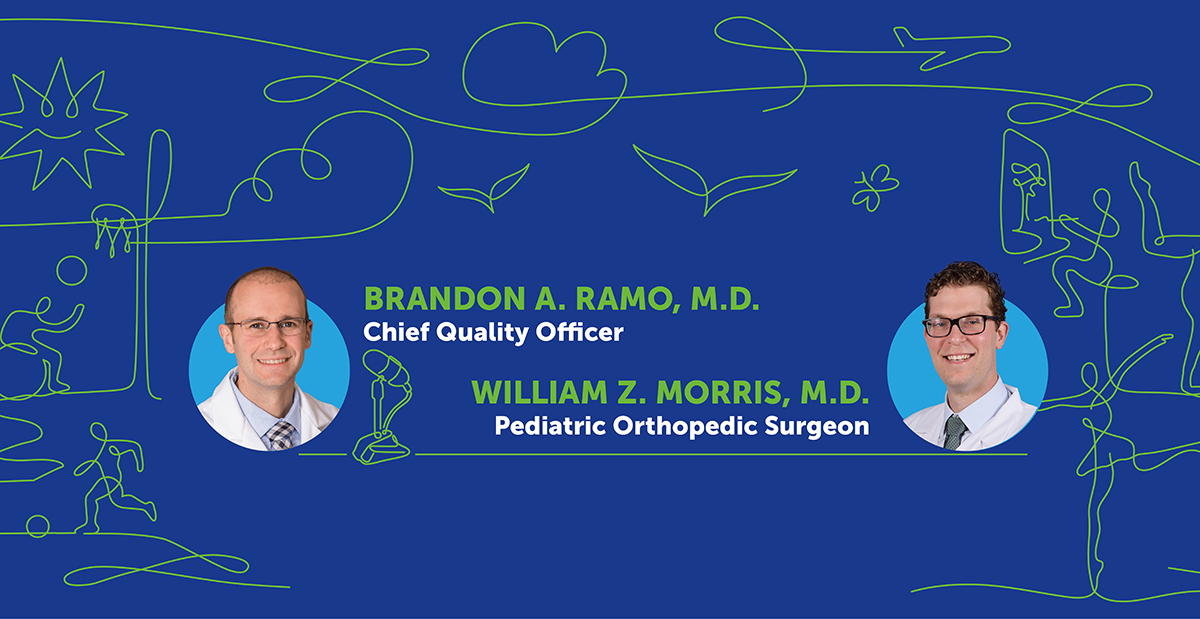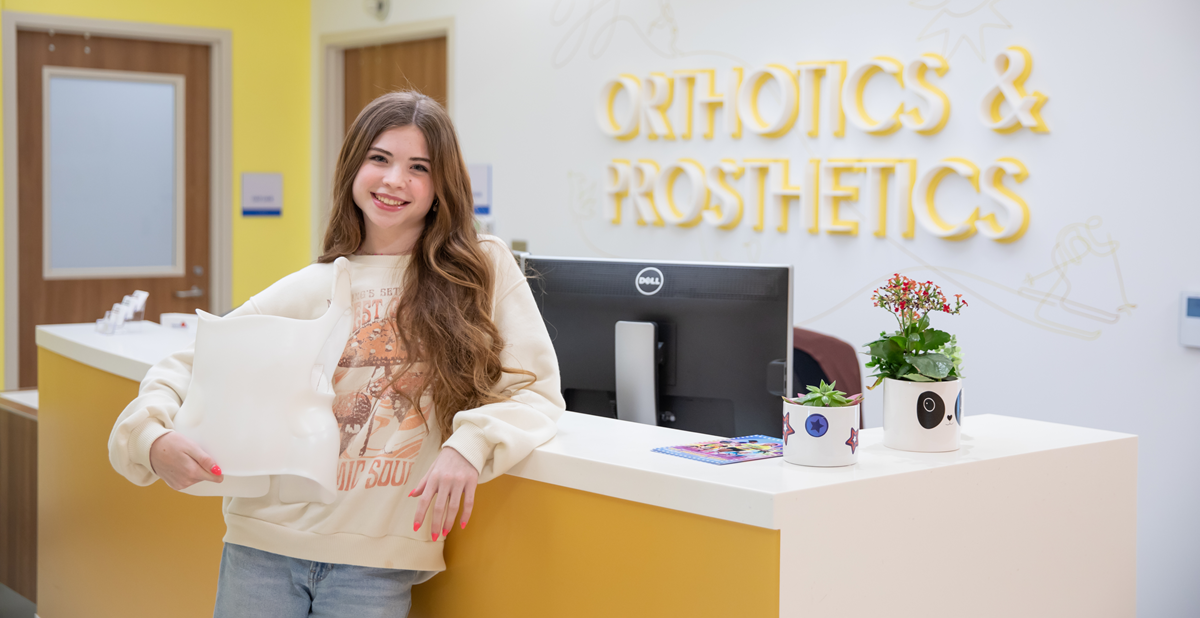
Dec 17, 2020 / Research & Innovation
Checking In - Spine Innovation
Checking In – A Scottish Rite for Children Podcast, Episode 3
Spine Innovation
Host: Clinical Nurse Manager, Jennifer Bowden, R.N.
Expert Guests: Chief Quality Officer, Brandon A. Ramo, M.D., and pediatric orthopedic surgeon, William Z. Morris, M.D.
Listen to the full episode.
Below are the highlights from this episode:
Why do we study the spine?
Spine research helps us improve how we care for patients diagnosed with scoliosis and other spinal deformities here at Scottish Rite. Surgically, we treat hundreds of patients with scoliosis every year, and we treat many times more than that number in clinic. Within each one of those encounters, there are countless ways that the research done at Scottish Rite has shaped how we approach our evaluation and treatment of patients. Our commitment to continually improve the care we provide our patients relies in part on the research that allows us to better understand conditions that affect the spine and how our treatments influence outcomes.
What is the Center for Excellence in Spine?
The Center for Excellence in Spine encompasses a large team, which serves both clinical and research purposes. It includes staff with expertise in different areas within the organization. Like all of our centers, the purpose of the spine center is to advance the care and treatment of children with scoliosis and other spinal deformities.
Scottish Rite is unique because our experts are all under one roof. For example, pediatric orthopedic surgeons can attend regular meetings with staff from other areas, and doctors can walk up to another floor to meet with our biomechanical engineers and discuss current research or a new project. Having all our experts together allows constant communication and collaboration.
What type of collaborative spine research with other institutions is Scottish Rite involved with?
These are called multi-center studies, which include hospitals from around the country. These studies allow our team to study a larger/shared patient population to find answers to our questions. This is especially helpful if the team is trying to better understand a rare condition or complication, and more patients are needed to find answers. The multi-center studies help all institutions provide better care for their patients by applying what we can learn through shared information.
Why is studying the spine/scoliosis so important?
Like all medical research, studying scoliosis and the spine is essential to know what's next and continue to make improvements for our patients. This goes on in many academic medical centers like Scottish Rite, but it's helpful to participate in research and to contribute to the scientific community by publishing papers looking at specific ideas and topics. Learning from the past lets us move towards a better future with better outcomes for our kids.
At our institution, we enjoy working with other centers around the country, and to some extent, around the world. We have a couple of multi-center projects that we work on and groups that we work with. One project that our team is involved with is The Pediatric Spine Study Group (PSSG). Doctors from our staff have been a part of that group for almost 15 years. PSSG allows us to study early-onset scoliosis in depth. Our patients are placed in an anonymous database to protect patient information. Our team can then pool from thousands of patients from the nearly 50 institutions around the world who participate in this group and ask them questions. Meanwhile, our colleagues from places like Boston or San Diego ask their questions and use data from our patients to receive answers.
What type of research is being conducted for scoliosis surgery?
Our research focuses on identifying ways to make surgery safer and more efficient, with improved outcomes for our patients. That may come from critically analyzing our results to identifying where opportunities for improvement may be. Other times it involves bringing innovation directly into the operating room to try to improve patient care.
For a patient family, what can they expect if they are asked to participate in a research study?
Many families seen at Scottish Rite are excited and willing to give back to the institution by participating in research. We have a team of research coordinators who talk with the families to discuss the study, what is expected and how their child can be involved.
What are the tools or resources used to help with research?
An EOS machine is a low-dose imaging system that provides both two-dimensional and three-dimensional imaging of the spine. The radiation generated by this imaging system is a fraction of standard radiography. This type of scan allows our team to understand the three-dimensional representation of scoliosis, which is a lot more complicated than what we see in a two-dimensional image. With this resource, we can also continue to learn more about what's happening with scoliosis and how this three-dimensional deformity affects our outcomes.
With a 3-D printer, advanced imaging from a CT scan is used to print a model of the spine, which helps our experts determine a plan for surgery, especially with complex cases.
Learn more about the research conducted in the Center for Excellence in Spine.
Listen to the latest episodes from Checking In – A Scottish Rite for Children Podcast.
Spine Innovation
Host: Clinical Nurse Manager, Jennifer Bowden, R.N.
Expert Guests: Chief Quality Officer, Brandon A. Ramo, M.D., and pediatric orthopedic surgeon, William Z. Morris, M.D.
Listen to the full episode.
Below are the highlights from this episode:
Why do we study the spine?
Spine research helps us improve how we care for patients diagnosed with scoliosis and other spinal deformities here at Scottish Rite. Surgically, we treat hundreds of patients with scoliosis every year, and we treat many times more than that number in clinic. Within each one of those encounters, there are countless ways that the research done at Scottish Rite has shaped how we approach our evaluation and treatment of patients. Our commitment to continually improve the care we provide our patients relies in part on the research that allows us to better understand conditions that affect the spine and how our treatments influence outcomes.
What is the Center for Excellence in Spine?
The Center for Excellence in Spine encompasses a large team, which serves both clinical and research purposes. It includes staff with expertise in different areas within the organization. Like all of our centers, the purpose of the spine center is to advance the care and treatment of children with scoliosis and other spinal deformities.
Scottish Rite is unique because our experts are all under one roof. For example, pediatric orthopedic surgeons can attend regular meetings with staff from other areas, and doctors can walk up to another floor to meet with our biomechanical engineers and discuss current research or a new project. Having all our experts together allows constant communication and collaboration.
What type of collaborative spine research with other institutions is Scottish Rite involved with?
These are called multi-center studies, which include hospitals from around the country. These studies allow our team to study a larger/shared patient population to find answers to our questions. This is especially helpful if the team is trying to better understand a rare condition or complication, and more patients are needed to find answers. The multi-center studies help all institutions provide better care for their patients by applying what we can learn through shared information.
Why is studying the spine/scoliosis so important?
Like all medical research, studying scoliosis and the spine is essential to know what's next and continue to make improvements for our patients. This goes on in many academic medical centers like Scottish Rite, but it's helpful to participate in research and to contribute to the scientific community by publishing papers looking at specific ideas and topics. Learning from the past lets us move towards a better future with better outcomes for our kids.
At our institution, we enjoy working with other centers around the country, and to some extent, around the world. We have a couple of multi-center projects that we work on and groups that we work with. One project that our team is involved with is The Pediatric Spine Study Group (PSSG). Doctors from our staff have been a part of that group for almost 15 years. PSSG allows us to study early-onset scoliosis in depth. Our patients are placed in an anonymous database to protect patient information. Our team can then pool from thousands of patients from the nearly 50 institutions around the world who participate in this group and ask them questions. Meanwhile, our colleagues from places like Boston or San Diego ask their questions and use data from our patients to receive answers.
What type of research is being conducted for scoliosis surgery?
Our research focuses on identifying ways to make surgery safer and more efficient, with improved outcomes for our patients. That may come from critically analyzing our results to identifying where opportunities for improvement may be. Other times it involves bringing innovation directly into the operating room to try to improve patient care.
For a patient family, what can they expect if they are asked to participate in a research study?
Many families seen at Scottish Rite are excited and willing to give back to the institution by participating in research. We have a team of research coordinators who talk with the families to discuss the study, what is expected and how their child can be involved.
What are the tools or resources used to help with research?
An EOS machine is a low-dose imaging system that provides both two-dimensional and three-dimensional imaging of the spine. The radiation generated by this imaging system is a fraction of standard radiography. This type of scan allows our team to understand the three-dimensional representation of scoliosis, which is a lot more complicated than what we see in a two-dimensional image. With this resource, we can also continue to learn more about what's happening with scoliosis and how this three-dimensional deformity affects our outcomes.
With a 3-D printer, advanced imaging from a CT scan is used to print a model of the spine, which helps our experts determine a plan for surgery, especially with complex cases.
Learn more about the research conducted in the Center for Excellence in Spine.
Listen to the latest episodes from Checking In – A Scottish Rite for Children Podcast.



